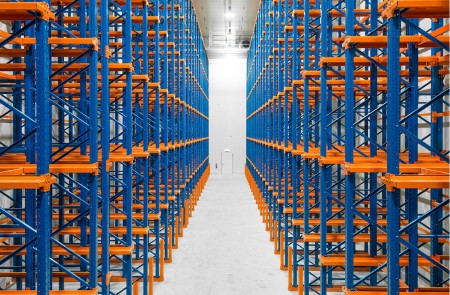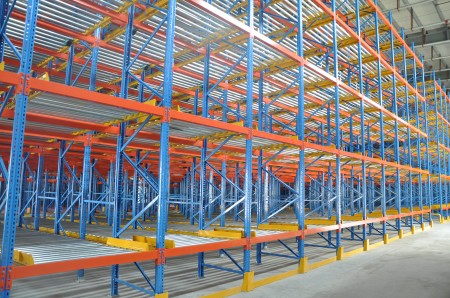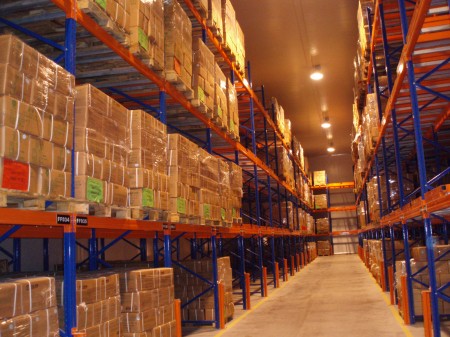There are several production forms for the back-pushing heavy-duty warehouse racks. However, the principle of production is basically the same!
1. Drive-in pallet racking
Drive-in pallet racking is also called corridor-type racks, drive-through pallet racking. This racking system has a high-density storage and the space utilization rate is quite high, which is almost twice that of pallet racking. It is worth mentioning that the system is applicable to small variety but large quantities stored products, especially for standard goods; The first pallet in is the last one out FILO (First in, Last Out) unless a Drive-Through system is used whereby pallets can be loaded or retrieved from either side.
First of all, the containerization work must be carried out to determine the specifications, load capacity and stack height of the pallet. From this, the span, depth, and layer spacing of the unit shelf are determined, and the height of rack is determined based on the effective height of the lower edge of the warehouse rack. The total depth of the racks in the wall area should be controlled within 6 tray depths, and the total depth of the middle racks area that can be accessed from both sides is preferably controlled within 12 tray depths to improve the efficiency and reliability of the forklift access(In such type of racking system, the forklift truck is a continuous operation form that “high-height and high-strike”, the forklift is liable to shake and hit the racks, so it is very important that the stability is fully considered).
The stability of such storage systems is relatively weak, and the racks should not be too high. Generally speaking, they should be controlled within 10m.To strengthen the stability of the entire racking system, not only the specifications and the selection should be larger, but also need to add a pull device.
Single-carriage goods should not be too large or heavy. Usually, the weight should be controlled within 1500kg, and the pallet span should not exceed 1.5m. The forklift often used as a forward battery forklift or a counterweight battery forklift. The racking system is mostly used in dairy products, beverages and other food industries, and is also commoner in cold storage.
2. Gravity rolling racking
Gravity rolling racking evolved from pallet racking, which use roller-type or bottom-wheeled trays, with a graded slope (about 3°). Making use of the weight of goods to achieve the first-in-first-out of the goods and enter from one side then come out from the other.
It is suitable for first-in, first-out storage operations for large batches and similar goods, and has high space utilization. It is especially suitable for goods that have a certain warranty period and are not suitable for long-term backlogs.
The total depth of the rack (i.e., the length of the guide rail) should not be too large; otherwise the unusable upper and lower “dead ends” will be larger to affect space utilization. And if the ramp is too long, the controllability of the slippage will be poor, and the impact of the slippage will be relatively large. It is easy to cause sluggishness, blocking, and tilting of palletized cargo. To make the down slide smooth, taking a long ramp for example, a damping device should be added in the middle. To make the pallet cargo fall to the bottom, it will not be tilted due to excessive impact force. The buffer device and the cargo separation device shall be installed at the lowest position of the ramp. Therefore, the design, manufacture, and installation are more difficulty and costly.
Such racks should not be too high, generally within 6m. The weight of a single pallet is generally within 1000kg, otherwise its reliability and operability will be reduced. There are not many applications for such racking systems in China.
3. Push back racking
Push-back racking is also evolved from pallet racking, which use the principle of a combination of rails and pallet cars, the track has a certain graded slope (about 3°).
Utilizing the weight of the goods to achieve the first-in-last-out of the goods, with the same side entering the same side coming out. It is suitable for the storage of goods with larger quantities and fewer varieties. The space utilization rate is quite high and the goods access is also more flexible and convenient. The total depth of racks should not be too deep, usually within the depth of 5-pallets, otherwise the space for the pallet trolleys will be greater due to mutual embedding. The weight of single-carriage goods is generally within 1500kg, and the height of rack is generally within 6m.
This type of system has a relatively high requirement for the manufacturing precision of the racks, and the cooperation between the tray trolley and the guide rails is particularly important. For example, if the manufacturing and installation accuracy is not in a high level, it is easy to cause the racks’ system to run unsmoothly. The cost of such racks is high and has already been applied in China.
Post time: 04-09-2018








